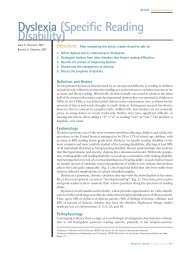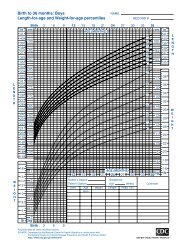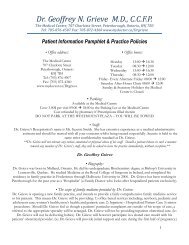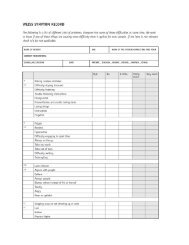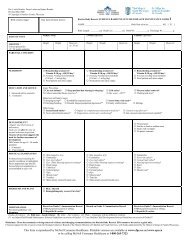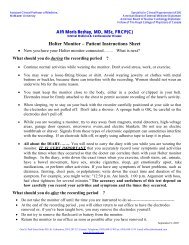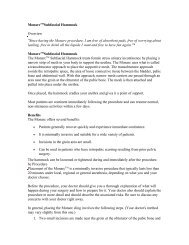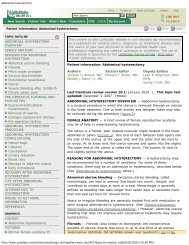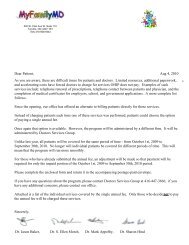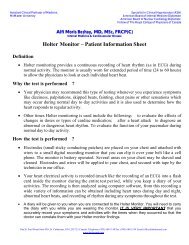BPPV -- <strong>BENIGN</strong> <strong>PAROXYSMAL</strong> <strong>POSITIONAL</strong> <strong>VERTIGO</strong>10/02/2005 01:37 PMwas 81%, compared to 37.% in placebo or untreated subjects. See here for the details.WHAT IF THE MANEUVERS DON'T WORK?These maneuvers are effective in about 80% of patients with BPPV. If you are among the other 20 percent,your doctor may wish you to proceed with the Brandt-Daroff exercises, as described below. If a maneuverworks but symptoms recur or the response is only partial (about 40% of the time according to Smouha,1997), another trial of the maneuver might be advised. The "habituation" exercises are also sometimesuseful in the situation where all other maneuvers (Epley, Semont, Brandt-Daroff) have been tried -- inessence these consist of a more intense and prolonged series of positional exercises. When all maneuvershave been tried, the diagnosis is clear, and symptoms are still intolerable, surgi<strong>ca</strong>l management (posterior<strong>ca</strong>nal plugging) may be offered.BPPV often recurs. About 1/3 of patients have a recurrence in the first year after treatment, and by fiveyears, about half of all patients have a recurrence (Hain et al, 2000; Nunez et al; 2000; Sakaida et al, 2003).If BPPV recurs, in our practice we usually retreat with one of the maneuvers above. While daily use ofBrandt-Daroff exercises would seem sensible, we did not find it to prevent recurrence (Helminski et al,2005).In some persons, the positional vertigo <strong>ca</strong>n be eliminated but imbalance persists. In these persons it may bereasonable to undertake a course of generic vestibular rehabilitation, as they may still need to compensatefor a changed utricular mass or a component of persistent vertigo <strong>ca</strong>used by cupulolithiasis. Conventionalvestibular rehabilitation has some effi<strong>ca</strong>cy, even without specific maneuvers. (Angeli, Hawley et al. 2003;Fujino et al ,1994) )HOME TREATMENT OF BPPV:BRANDT-DAROFF EXERCISESClick here for a low bandwidth animationThe Brandt-Daroff Exercises are a method oftreating BPPV, usually used when the officetreatment fails. They succeed in 95% of <strong>ca</strong>ses but aremore arduous than the office treatments. Theseexercises may take longer than the other maneuvers -- the response rate at one week is about 25% (Radkeet al, 1999). These exercises are performed in threesets per day for two weeks. In each set, one performsthe maneuver as shown five times.1 repetition = maneuver done to each side in turn(takes 2 minutes)Suggested Schedule forhttp://www.dizziness-and-balance.com/disorders/bppv/bppv.htmlPage 6 of 13
BPPV -- <strong>BENIGN</strong> <strong>PAROXYSMAL</strong> <strong>POSITIONAL</strong> <strong>VERTIGO</strong>10/02/2005 01:37 PMBrandt-Daroff exercisesTime Exercise DurationMorningNoonEvening5repetitions5repetitions5repetitions10minutes10minutes10minutesStart sitting upright (position 1). Then move into the side-lying position (position 2), with the head angledupward about halfway. An easy way to remember this is to imagine someone standing about 6 feet in frontof you, and just keep looking at their head at all times. Stay in the side-lying position for 30 seconds, oruntil the dizziness subsides if this is longer, then go back to the sitting position (position 3). Stay there for30 seconds, and then go to the opposite side (position 4) and follow the same routine.These exercises should be performed for two weeks, three times per day, or for three weeks, twice per day.This adds up to 52 sets in total. In most persons, complete relief from symptoms is obtained after 30 sets, orabout 10 days. In approximately 30 percent of patients, BPPV will recur within one year. If BPPV recurs,you may wish to add one 10-minute exercise to your daily routine (Amin et al, 1999). The Brandt-Daroffexercises as well as the Semont and Epley maneuvers are compared in an article by Brandt (1994), listed inthe reference section.When performing the Brandt-Daroff maneuver, <strong>ca</strong>ution is advised should neurologi<strong>ca</strong>l symptoms (i.e.weakness, numbness, visual changes other than vertigo) occur. Oc<strong>ca</strong>sionally such symptoms are <strong>ca</strong>used bycompression of the vertebral arteries (Sakaguchi et al, 2003). In this situation we advise not proceeding withthe exercises and consulting ones physician.Supplemental material on the site CD: Animation of Brandt-Daroff exercises. Note that this treatment maneuver is done faster in the animation than in actual use.Usually one allows 30 seconds between positions.Supplemental material on the site CD: Movie of Brandt-Daroff exercisesHOME EPLEY MANEUVERThe Epley and/or Semont maneuvers as described above <strong>ca</strong>n be done at home (Furman and Hain, 2004).For example, http://www.charite.de/ch/neuro/vertigo.html outlines a self-treatment Epley protocol. We mayrecommend the home-Epley to our patients who have a clear diagnosis. This procedure seems to be evenmore effective than the in-office procedure, perhaps be<strong>ca</strong>use it is repeated every night for a week.There are, however, several possible problems that may arise. If the diagnosis of BPPV has not beenconfirmed, one may be attempting to treat another condition (such as a brain tumor or stroke) withpositional exercises -- this is unlikely to be successful and may delay proper treatment. A second problem isthat the home-Epley requires knowledge of the "bad" side. Sometimes this <strong>ca</strong>n be tricky to establish.Compli<strong>ca</strong>tions such as conversion to another <strong>ca</strong>nal (see below) <strong>ca</strong>n occur during the Epley maneuver, whichare better handled in a doctor's office than at home. Finally, oc<strong>ca</strong>sionally during the Epley maneuverneurologi<strong>ca</strong>l symptoms are provoked due to compression of the vertebral arteries. In our opinion, it is saferhttp://www.dizziness-and-balance.com/disorders/bppv/bppv.htmlPage 7 of 13




